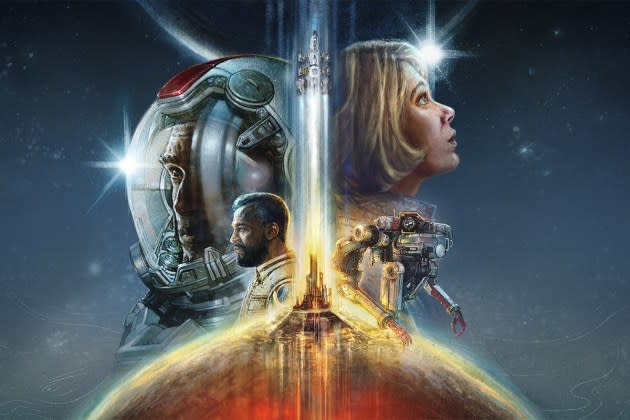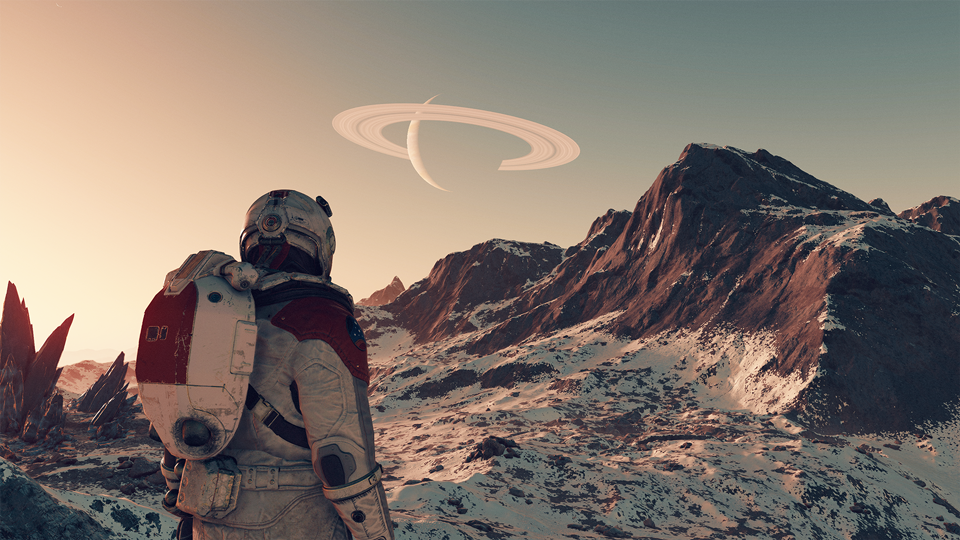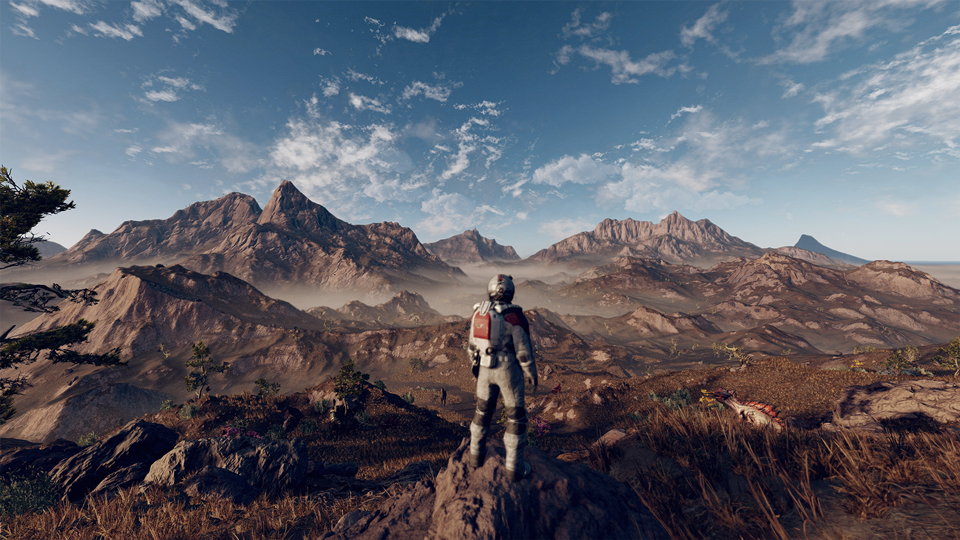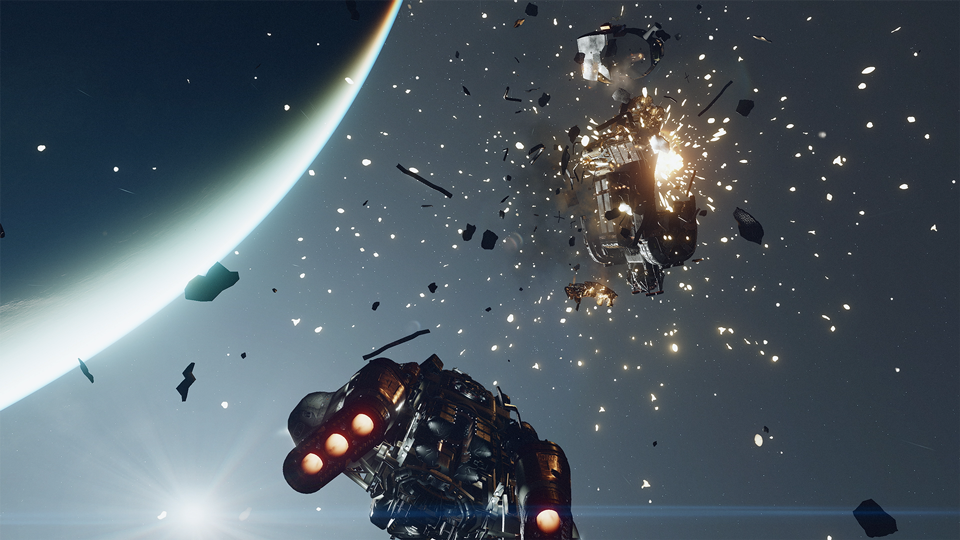‘Starfield’ Is Great, But It’s Not Destined To Save Xbox

It’s no secret that Microsoft’s Xbox has been having a rough couple of years. Trailing behind its competitors Sony and Nintendo, in both sales and cultural cachet, the brand that once dominated the console shooter space with the Halo and Gears of War series has struggled to find its footing with first-party development as both franchises fell to mediocrity in their later releases.
But of course, Microsoft has a bed made of money to fall back on, and their solution thus far has been (attempting) to gobble up as many publishers, developers, and prestigious IP that they can, beginning with its $7.5B acquisition of ZeniMax Media and its studio Bethesda Softworks in 2021. With that, mega-franchises like Doom, Wolfenstein, Fallout, and The Elder Scrolls suddenly became Xbox property — and eventual exclusives. This was all supposed to be the dawn of a new era, kicking off with the Xbox Series X|S and Windows-exclusive launch of Arkane Austin’s vampire shooter Redfall. It didn’t work out.
More from Rolling Stone
'Final Fantasy XVI' Is a Cinematic Peak for a Never-Ending Franchise
Outrage Over 'Call of Duty' LGBTQ Pride Brings Us Full Circle to Gamergate
In the time since, Microsoft has continued its conquest for industry dominance with a potential $68.7B deal(!) to acquire Activision Blizzard, which houses some little-known games like Diablo and Call of Duty. But while that battle plays out in court, gamers’ biggest and best hope for an Xbox revolution rests in the hands of Bethesda first new IP in nearly thirty years. Is it up to the task?
The short answer? No, and it doesn’t need to be.
Fanboy politicking aside, the hype surrounding Starfield since its announcement in 2018 was always going to work against it. Developed by Bethesda Game Studios, with veteran game director Todd Howard at the helm, the expectations were high for the game, billed as the space bound successor to the Fallout and Elder Scrolls series. Dubbed “Skyrim in space” by Howard himself, the impact was immediate.
Invoking the name Skyrim has weight; it’s one of the most commercially and critically successful RPGs of all time, inspiring a cultural tsunami of memes during its release in 2011 and influencing every single game since that even brushes against the idea of creating an “open world.”
Thankfully, Starfield is true to its pedigree. It’s a sprawling, role-playing spectacle driven almost entirely by player choice — almost to a fault. Seriously, there is almost no way to describe the sheer size of this game without sounding ridiculous. Touted as having over a thousand planets to explore, built through a mix of procedural generation and intricate design, the game is downright intimidating. And it doesn’t even attempt to hold your hand.

The basic setup is that you — through a custom character — are a miner working on the Argos Extractors Mining Outpost on the Moon of Vectera in the year 2330. Humanity has spread across the cosmos and you’re just a tiny part of it, or have been… until now. Upon discovering a mysterious artifact and having a psychedelic reaction, you find yourself thrust into a larger story. Waking up, you’re introduced to a nebulous (no pun intended) organization called Constellation. You’re important now and so are they, and it’s time to step out and begin a massive adventure.
“Step out” is a key word here — it’s a term often used for the first time a player has the scope of the world first revealed to them in a game, and in Starfield, there’s actually two instances. The first is the “traditional” moment where the player, either in first-person or third-person perspective, exits the med bay to see the moon’s surface with all the glory of the ethereal sky and orbit planet in full view. It’s mesmerizing, partly because of the setting but also because the game is genuinely beautiful. It’s a huge step up from the visual of Bethesda’s last single-player release, 2015’s Fallout 4. From here, you get into a gun fight, get gifted a starship, and are free to go in any direction you want.

In some ways, it still feels as novel a start as it did in Skyrim, but a problem quickly arises: If you’re the type of player who, when given an open world to explore, chooses to instantly go the opposite way of your objective (*raises hand*), you’re going to be disappointed. The planet is almost entirely barren save for a few caves and canyons. It really takes the wind out of your solar sail to have the freedom to go anywhere only to find absolutely nothing. It’s a problem that persists through the games dozens (and dozens) of hours but is somewhat mitigated whenever you find one of the specific planets that has a major civilization or lusher biosphere.
And even when planets aren’t empty, they often feel lifeless. The first major city you’re pushed toward in the main questline is New Atlantis. It’s massive in size, although it feels bigger given how slow your character is on their feet, and it’s got a very confusing geography. I must have spent the better part of the first ten hours of the game checking off as many side quests and favors as I could across the city’s different neighborhoods, and I’m positive that I still don’t know how to traverse it without checking for a map every five minutes. Except there isn’t one — not really.
The lack of any basic mini map on individual planets is indicative of a larger issue with the game: it’s just not intuitive to navigate. That circles back to the second “step out” moment at the onset of the game. After you’ve been given a ship and have the freedom to chart your way across the stars, you have access to a navigational menu that pinpoints your location on the current moon. Then you hit a back key and suddenly that moon shrinks to a minute dot on a map of the solar system, alongside all the other planets and their satellites. Hit it again, and suddenly that solar system is a blip in a sea of star systems. It’s a definitive “holy shit” moment.

But the feeling of awe gives way to frustration. Sure, there’s a waypoint marker for a quest that will likely start pointing me in the right direction (spoiler: it only sort of does), but there’s a difference between refusing to coddle players and dropping them into the abyss of space without a clue. What you’ll learn is that while you can land on planets, there’s no obvious tutorial for selecting the accessible zones or points to land on, or how jumping to other planets works, or even what constitutes fuel. It extends back to the on the ground gameplay, where everything from selecting new gear to just checking your next directive is in a menu within a menu.
It’s encumbering — literally — as I also spent the first few hours of the game perpetually “over-encumbered” by weight after gathering way too many crafting supplies and minerals that I assumed would become essential, exceeding my character and companion’s inventory capacity. I wouldn’t organically learn how to access my ship’s cargo storage until hours later after completing an optional side quest to enlist in the space army. This is what the game considers a “tutorial.” In reality, the place to learn how to actually play the game is also buried in menus: specifically by accessing the Data Menu > Systems Menu > Help Menu. It’s even less intuitive than the video game slipcover manuals of yore.
If this all sounds like bellyaching about too much player choice, rest assured it’s not. The best aspects of the game are driven by Bethesda’s beloved design philosophies around player choice in where you go and how you approach every scenario, from combat to dialogue trees, and the ripple effects it’ll have throughout your hundred-hour-long campaign. Or more, given that Bethesda’s own head of publishing Pete Hines recently said that the game takes a measly 130 hours or so to really get going. He also said in a recent interview that, “the first three to four hours are a little bit hunt-and-peck, like ‘what am I actually doing?” It’s not the flex he thinks it is.

So what are you actually doing with all that time? So much. The basic loop is: get a quest (or just curiosity) that leads you to a solar system, pick your planet or moon, drop down and explore. You’ll find more questions, seemingly endless bits of lore, fight people and aliens alike, collect items, weapons, outfits, and gear, rinse and repeat. You’ll also craft medicine and upgrades, do chemistry and research projects, and build entire space outposts. In between, you’ll make alliances, enemies, and impact the balance of power among the stars in search of answers as part of Constellation. You can also dog fight in space! Or hold awkward conversations in space? Other ships can hail you in a very strange play on the usual 1:1 dialogue trees Bethesda RPGs are known for. It’s as strange as it sounds.
It’s all overwhelming, but it does get more manageable one you know what you’re doing. However while the extraplanetary appeal and retro-futuristic flourishes give it the feeling that it’s an ultimate evolution of a Space Quest-style game from the Sierra era in the late 1980’s, it also shares that sort of regressive clunkiness.
The clunkiness also applies to the moment-to-moment combat. As billed, the game is ostensibly Skyrim in space, but the combat shares more in common with Fallout 4 given its propensity to arming players to the teeth with ballistics and pew pews. And while gunplay, stealthy, and melee work as serviceably as it does in any Bethesda RPG, it’s fair to say controls and execution feel smoother and more refined than ever for the developer, even if it lacks the defined crunch of the combat in other RPG-shooters like Cyberpunk 2077. Killing humans can feel morbidly satisfying with a critical hit, but aliens (especially at higher levels) tend to feel like bullet sponges and there’s no strategic system like V.A.T.S. from the Fallout series to slow things down and give players the edge.
So no, Starfield isn’t exactly the savior that the Xbox portfolio needs to salvage its anemic first-party lineup, but if you can get through the first few dozen hours or so to where it clicks, it mostly delivers on what a reasonable person’s expectations for the next Bethesda game should be. It’s a visually striking, mostly bug-free experience from a triple-A developer that scratches a very special open-world itch. And if anything, it’s certainly long enough to be the only Xbox game you’ll ever need again. You can play it again in New Game+ until humanity actually does colonize space.
Starfield launches on Xbox Series X|S and Windows on September 6. It’s also available day one for Game Pass subscribers.
Best of Rolling Stone

